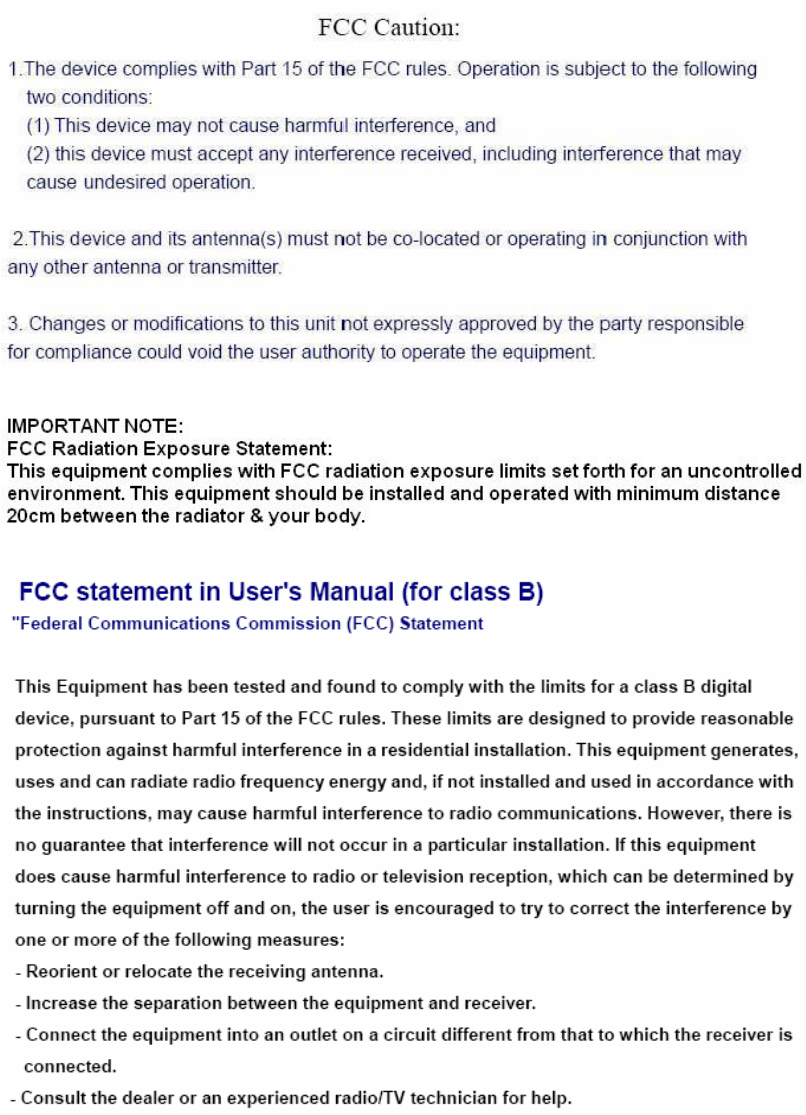NetComm Wireless N3G007W NetComm 3G Wireless Router User Manual WMQ136AM
NetComm Wireless Limited NetComm 3G Wireless Router WMQ136AM
Contents
- 1. User manual 1 of 2
- 2. User manual 2 of 2
User manual 2 of 2
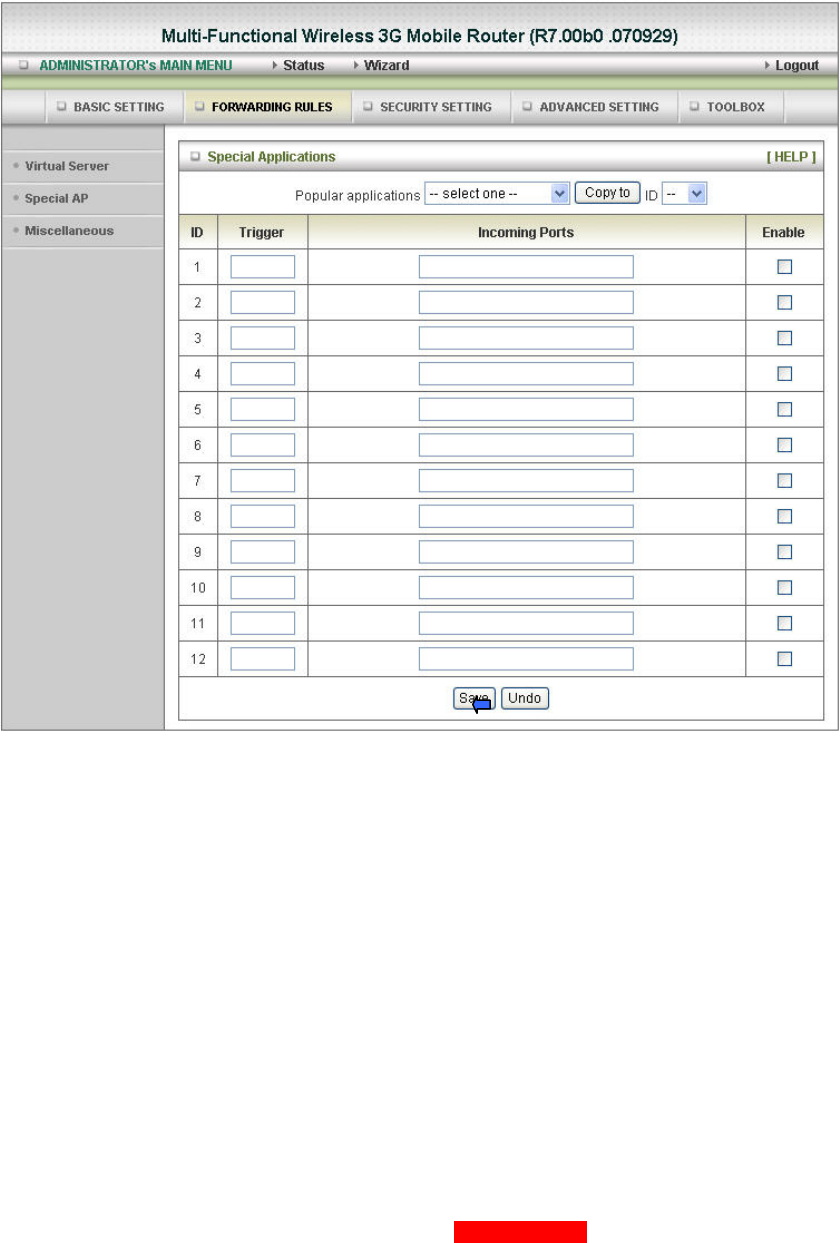
Some applications require multiple connections, like Internet games, Video conferencing,
Internet telephony, etc. Because of the firewall function, these applications cannot work with a
pure NAT router. The Special Applications feature allows some of these applications to work
with this product. If the mechanism of Special Applications fails to make an application work,
try setting your computer as the DMZ host instead.
1. Trigger: the outbound port number issued by the application.
2. Incoming Ports: when the trigger packet is detected, the inbound packets sent to the
specified port numbers are allowed to pass through the firewall.
This product provides some predefined settings.
1. Select your application and
2. Click Copy to to add the predefined setting to your list.
Note! At any given time, only one PC can use each Special Application tunnel.
Click on “Save” to store what you just select or” Undo” to give up
Advanced Setup > Forwarding Rules > Miscellaneous
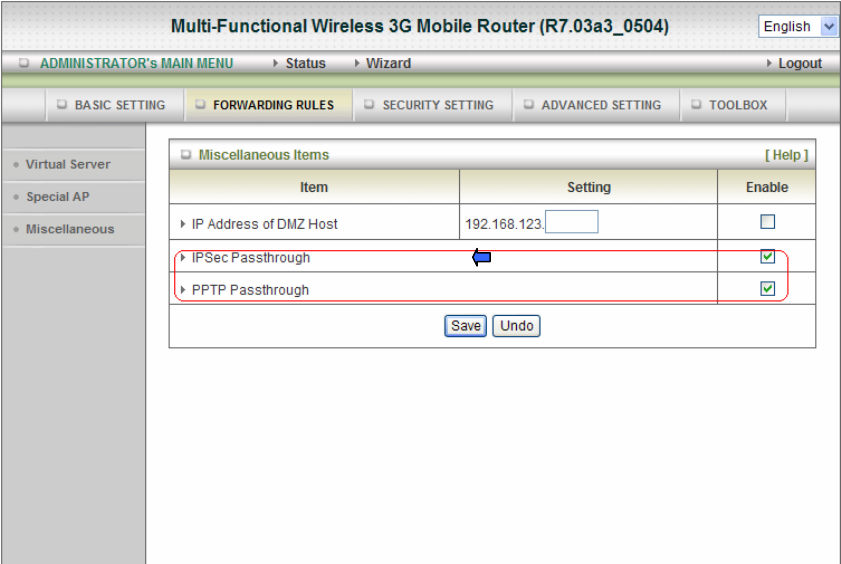
IP Address of DMZ Host
DMZ (Demilitarized Zone) Host is a host without the protection of firewall. It allows a
computer to be exposed to unrestricted 2-way communication for Internet games, Video
conferencing, Internet telephony and other special applications.
IPSec / PPTP Passthrough
The device also supports VPN Pass-through (IPSec/PPTP Pass-through). Once VPN
pass-through is enabled, multiple VPN connections can be made through the device. This
is useful when you have many VPN clients on the LAN.
Click on “Save” to store what you just select or “Undo” to give up
NOTE: This feature should be used only when needed.
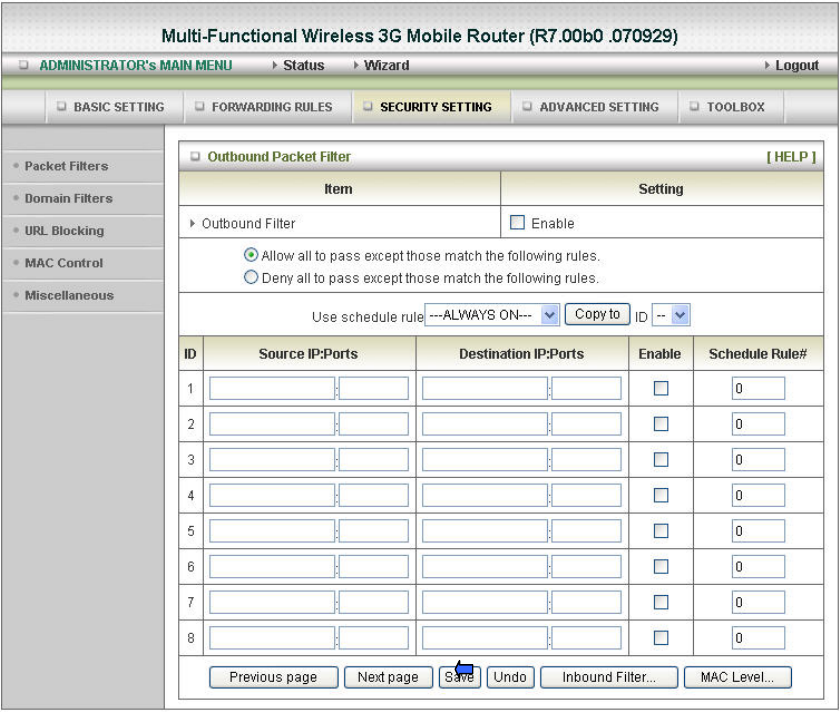
Advanced Setup > Security Setting > Packet Filters
Packet Filter enables you to control what packets are allowed to pass the router. Outbound filter
applies on all outbound packets. However, inbound filter applies on packets that destined to
Virtual Servers or DMZ host only. You can select one of the two filtering policies:
1. Allow all to pass except those match the specified rules
2. Deny all to pass except those match the specified rules
You can specify 8 rules for each direction: inbound or outbound. For each rule, you can define
the following:
• Source IP address
• Source port
• Destination IP address
• Destination port
• Protocol: TCP or UDP or both.
• Use Rule#
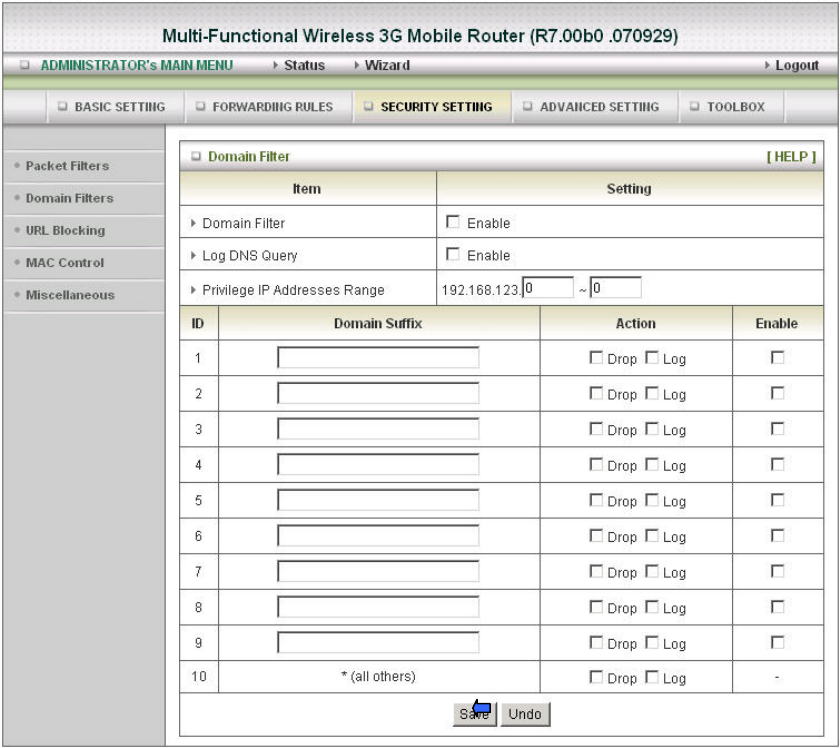
For source or destination IP address, you can define a single IP address (4.3.2.1) or a range of
IP addresses (4.3.2.1-4.3.2.254). An empty implies all IP addresses.
For source or destination port, you can define a single port (80) or a range of
ports (1000-1999). Add prefix "T" or "U" to specify TCP or UDP protocol. For
example, T80, U53, U2000-2999, No prefix indicates both TCP and UDP are
defined. An empty implies all port addresses. Packet Filter can work with
Scheduling Rules, and give user more flexibility on Access control. For Detail,
please refer to Scheduling Rule. Each rule can be enabled or disabled
individually.
Click on “Save” to store what you just select or “Undo” to give up
Inbound Filter:
To enable Inbound Packet Filter click the check box next to Enable in the Inbound Packet
Filter field
Click on “Save” to store what you just select or “Undo” to give up
Advanced Setup > Security Setting > Domain Filters
Domain Filter
let you prevent users under this device from accessing specific URLs.
Domain Filter Enable
Check if you want to enable Domain Filter.
Log DNS Query
Check if you want to log the action when someone accesses the specific URLs.
Privilege IP Address Range
Setting a group of hosts and privilege these hosts to access network without restriction.
Domain Suffix
A suffix of URL to be restricted; For example, ".com", "xxx.com".
Action
When someone is accessing the URL met the domain-suffix, what kind of action you
want.
Check drop to block the access. Check log to log these access.
Enable
Check to enable each rule.
Click on “Save” to store what you just select or “Undo” to give up
Advanced Setup > Security Setting > URL Blocking
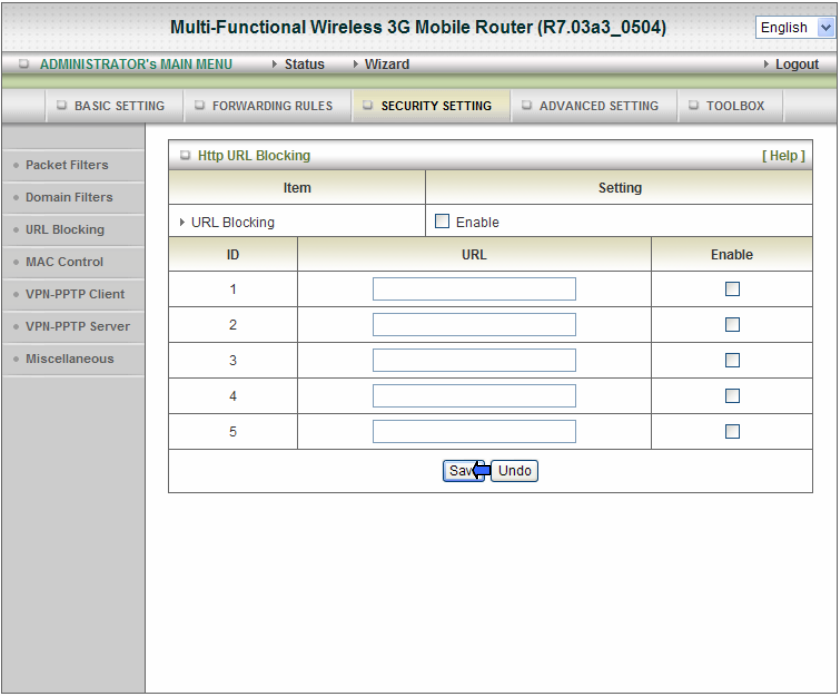
URL Blocking will block LAN computers to connect to pre-defined Websites.
The major difference between “Domain filter” and “URL Blocking” is Domain filter
require user to input suffix (like .com or .org, etc), while URL Blocking require user to
input a keyword only. In other words, Domain filter can block specific website, while
URL Blocking can block hundreds of websites by simply a keyword.
URL Blocking Enable
Check if you want to enable URL Blocking.
URL
If any part of the Website's URL matches the pre-defined word, the connection will be
blocked.
For example, you can use pre-defined word "sex" to block all websites if their URLs
contain pre-defined word "sex".
Enable
Check to enable each rule.
Click on “Save” to store what you just select or “Undo” to give up
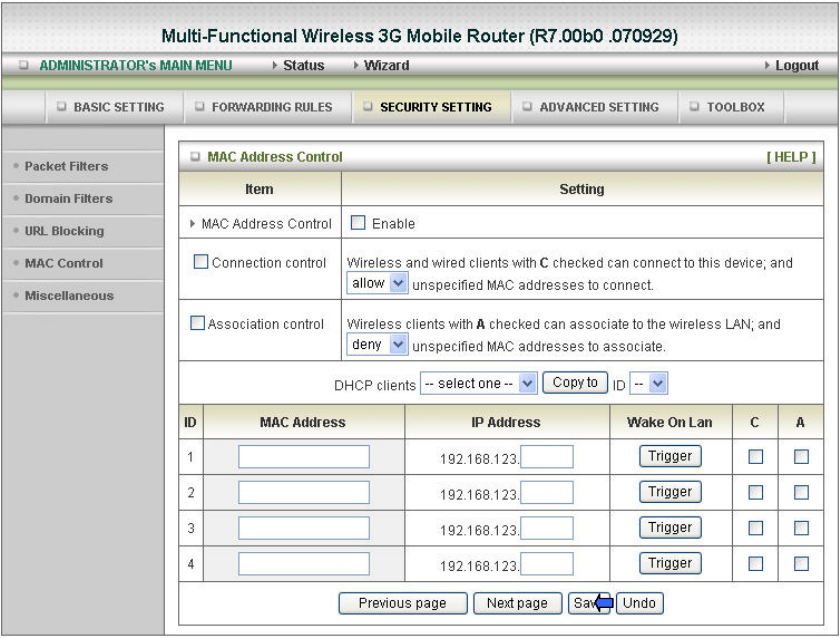
Advanced Setup > Security Setting > MAC Control
MAC Address Control allows you to assign different access right for different users and to
assign a specific IP address to a certain MAC address.
MAC Address Control Check “Enable” to enable the “MAC Address Control”. All of the
settings in this page will take effect only when “Enable” is
checked.
Connection control Check "Connection control" to enable the controlling of which
wired and wireless clients can connect to this device. If a client is
denied to connect to this device, it means the client can't access to
the Internet either. Choose "allow" or "deny" to allow or deny the
clients, whose MAC addresses are not in the "Control table"
(please see below), to connect to this device.
Association control Check "Association control" to enable the controlling of which
wireless client can associate to the wireless LAN. If a client is
denied to associate to the wireless LAN, it means the client can't
send or receive any data via this device. Choose "allow" or
"deny" to allow or deny the clients, whose MAC addresses are
not in the "Control table", to associate to the wireless LAN
1: Click on “Save” to store what you just select or “Undo” to give up
2: Click on “Next Page” to go down or “Previous page” back to last page
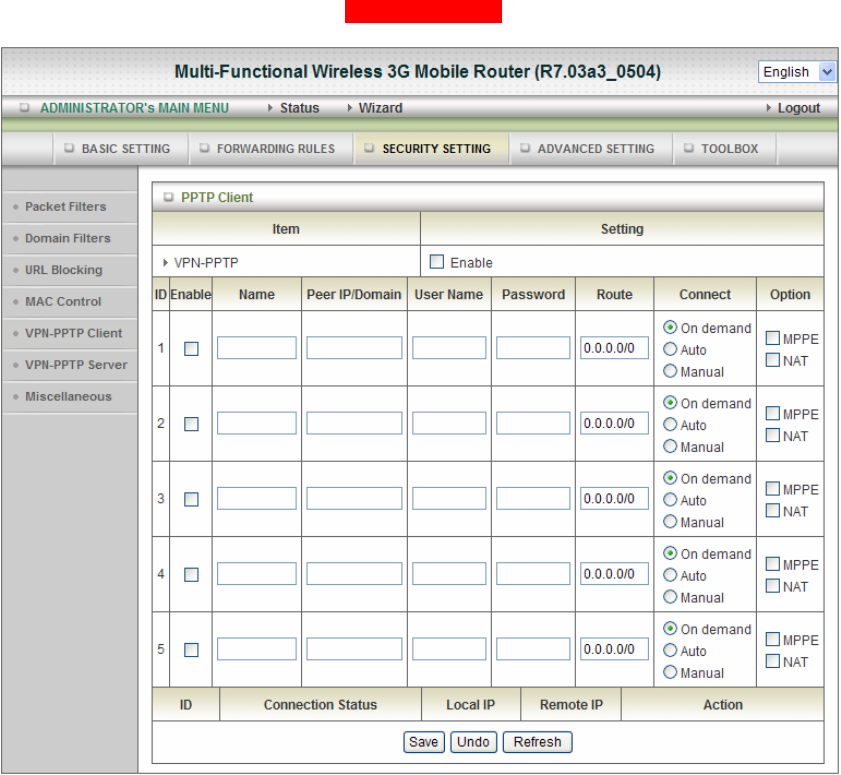
Advanced Setup > Security Setting > VPN-PPTP Client
VPN-PPTP: Enables or Disables the PPTP client.
Enable: Check to enable each rule.
Name: The name of Item.
Peer IP/Domain: The IP/Domain of PPTP server is.
PPTP Account and Password: The account and password your ISP assigned to you. If you don't
want to change the password, keep it empty.
Route: Which connection will use the PPTP section?
Connect: There are 3 modes to select:
On demand: The device will link up with ISP when the clients send outgoing packets.
Auto: The device will link with ISP until the connection is established.
Manually: The device will not make the link until someone clicks the connect-button in the
Status-page.
Option:
MPPE: The MPPE encryption supports.
NAT: The Nat Traversal supports.
Click on “Save” to store what you just select or” Undo” to give up
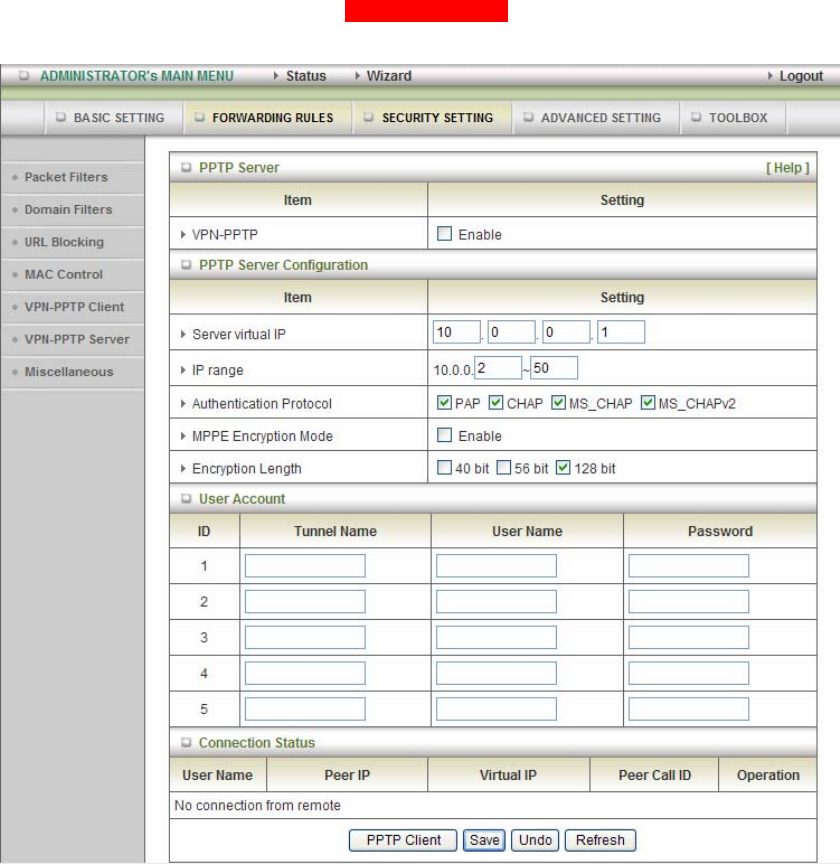
Advanced Setup > Security Setting > VPN-PPTP Server
The Router can behave as a PPTP server, and allows remote hosts to access LAN servers after establishing
PPTP connection with it. The device can support three authentication methods: PAP, CHAP, MSCHAP(v1)
and MSCHAP(v2). Users can also enable MPPE encryption when using MSCHAP.
VPN-PPTP:
Check this checkbox to enable function of PPTP server.
Server virtual IP:
The IP address of PPTP server. This IP address should be different from IP address of PPTP
server and LAN subnet of VPN gateway.
IP range:
The client IP range. IPs in this range are given clients trying to connect.
Authentication Protocol:
Users can choose authentication protocol as PAP, CHAP, or MS_CHAP(v1), MS_CHAP(v2).
MPPE Encryption Mode:
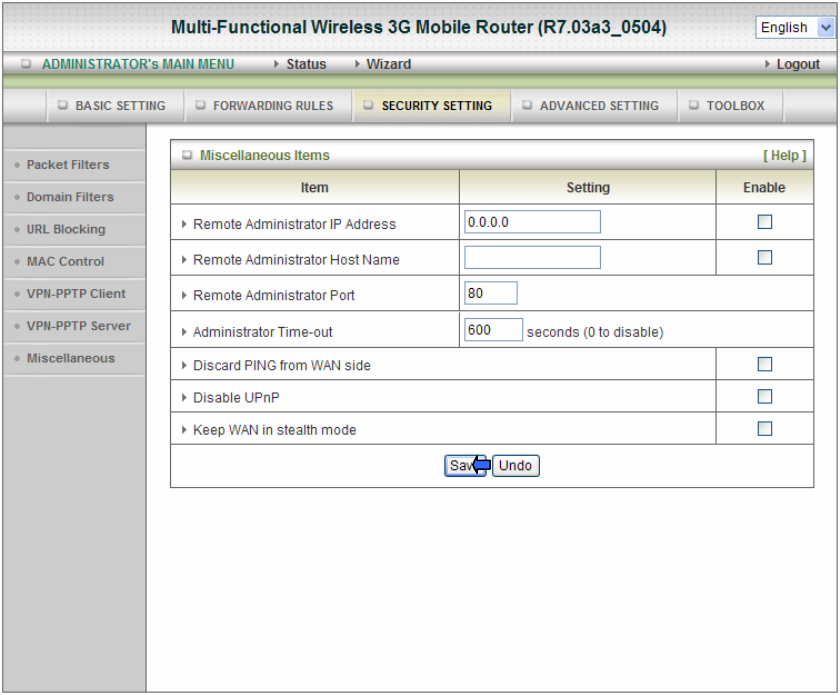
Check this checkbox to enable MPPE encryption. Please note that MPPE needs to work with
MSCHAP authentication method.
Encryption Length:
There are 3 kind of encryption for MPPE, 40bits, 56bits and 128bits.
User Account Setting
Users can input five different user accounts for PPTP server. The total accounts are 5.
1. Tunnel Name: Input the name for tunnel.
2. User Name: Input a user name that is allowed to establish PPTP connection with VPN gateway.
3. Password: Input the password for the user.
Click on “Save” to store what you just select or” Undo” to give up
Advanced Setup > Security Setting > Miscellaneous
Remote Administrator Host/Port
In general, only Intranet user can browse the built-in web pages to perform
administration task. This feature enables you to perform administration task from
remote host. If this feature is enabled, only the specified IP address can perform
remote administration. If the specified IP address is 0.0.0.0, any host can connect to
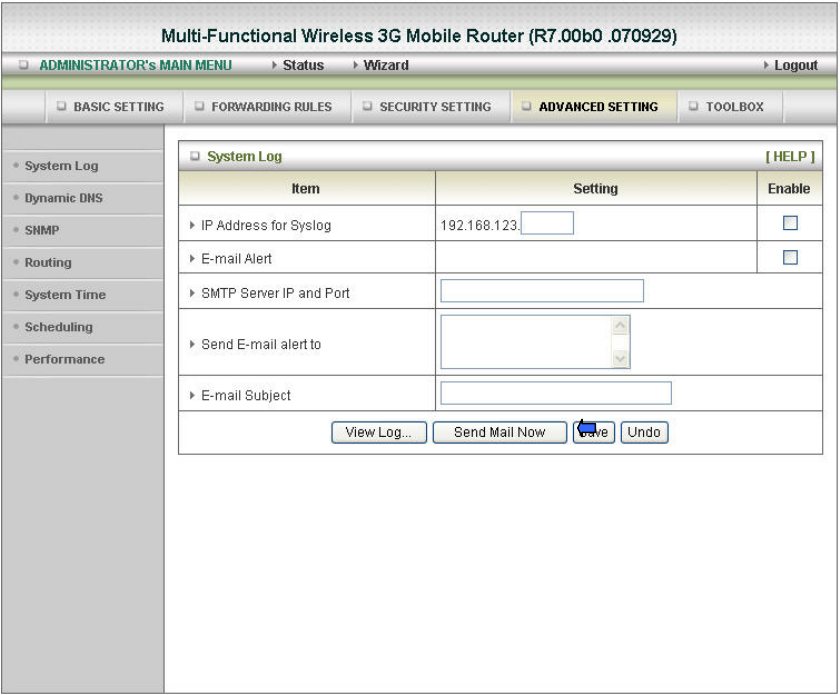
this product to perform administration task. You can use subnet mask bits "/nn"
notation to specified a group of trusted IP addresses for example, "10.1.2.0/24".
NOTE: When Remote Administration is enabled, the web server port will be shifted to
80. You can change web server port to other port, too.
Administrator Time-out
The time of no activity to logout automatically, you may set it to zero to disable this
feature.
Discard PING from WAN side
When this feature is enabled, any host on the WAN cannot ping this product.
Disable UPNP:
The device can disable UPNP function. If your OS supports UPNP search function and
you enable UPNP, like Windows XP. You can get Device IP by UPNP.
Keep WAN in stealth mode:
If the port is not open, the device just to ignore incoming connection attempts, rather
than rejecting them.
Click on “Save” to store what you just select or” Undo” to give up
Advanced Setup > Advanced Setting > System Log
This page support two methods to export system logs to specific destination by means of
syslog (UDP) and SMTP(TCP). The items you have to setup including:
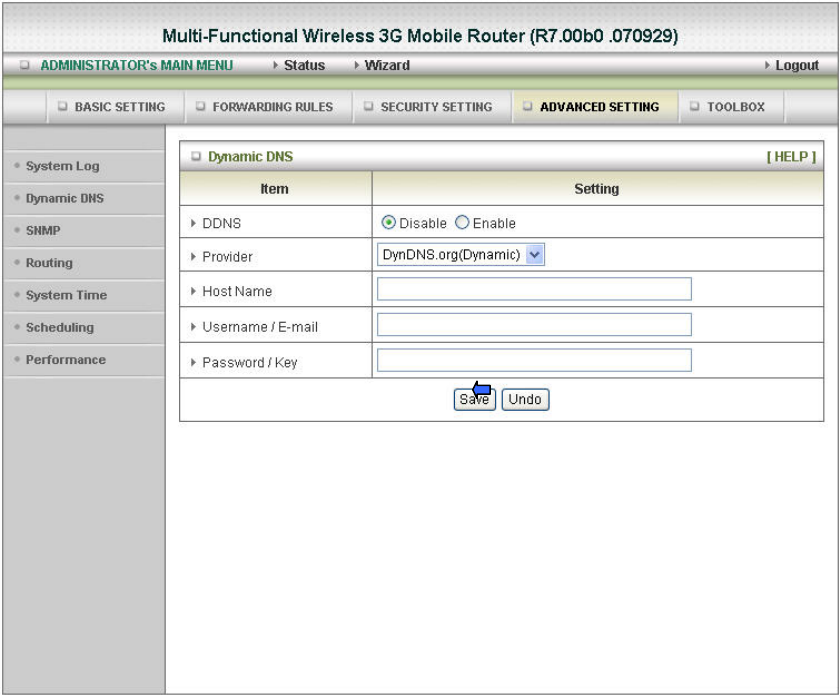
IP Address for Syslog
Host IP of destination where syslog will be sent to.
Check Enable to enable this function.
E-mail Alert Enable
Check if you want to enable Email alert (send syslog via email).
SMTP Server IP and Port
Input the SMTP server IP and port, which are concated with ':'. If you do not specify
port number, the default value is 25.
For example, "mail.your_url.com" or "192.168.1.100:26".
Send E-mail alert to
The recipients who will receive these logs, you can assign more than 1 recipient, using
';' or ',' to separate these email addresses.
E-mail Subject
The subject of email alert, this setting is optional.
Click on “Save” to store what you just select or “Undo” to give up
Advanced Setup > Advanced Setting > Dynamic DNS
To host your server on a changing IP address, you have to use dynamic domain name service
(DDNS).
So that anyone wishing to reach your host only needs to know the name of it. Dynamic DNS
will map the name of your host to your current IP address, which changes each time you
connect your Internet service provider.
Before you enable Dynamic DNS, you need to register an account on one of these Dynamic
DNS servers that we list in provider field.
To enable Dynamic DNS click the check box next to Enable in the DDNS field.
Next you can enter the appropriate information about your Dynamic DNS Server.
You have to define:
Provider
Host Name
Username/E-mail
Password/Key
You will get this information when you register an account on a Dynamic DNS
server.
Click on “Save” to store what you just select or “Undo” to give up
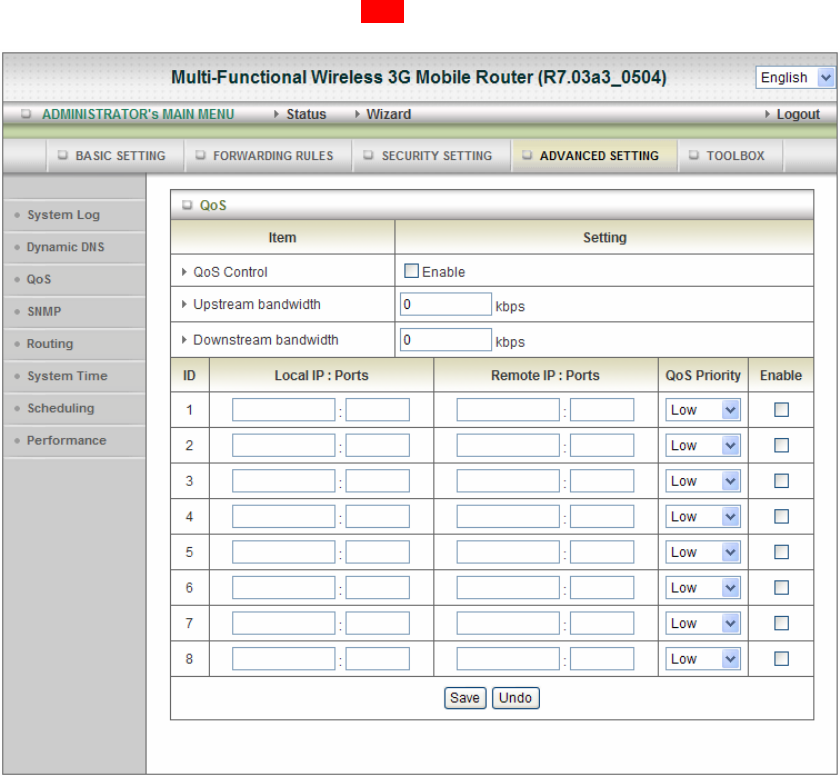
Advanced Setup > Advanced Setting > QOS
Provide different priority to different users or data flows, or guarantee a certain level of performance.
QoS Packet Filter
This Item enables QoS function or not.
Upstream Bandwidth
Set the limitation of upstream speed.
Downstream Bandwidth
Set the limitation of downstream speed.
Local: IP
Define the Local IP address of packets here.
Local: Ports
Define the Local port of the packets in this field.
Remote: IP
Define the Remote IP address of packets here.
Remote: Ports
Define the Remote port of the packets in this field.
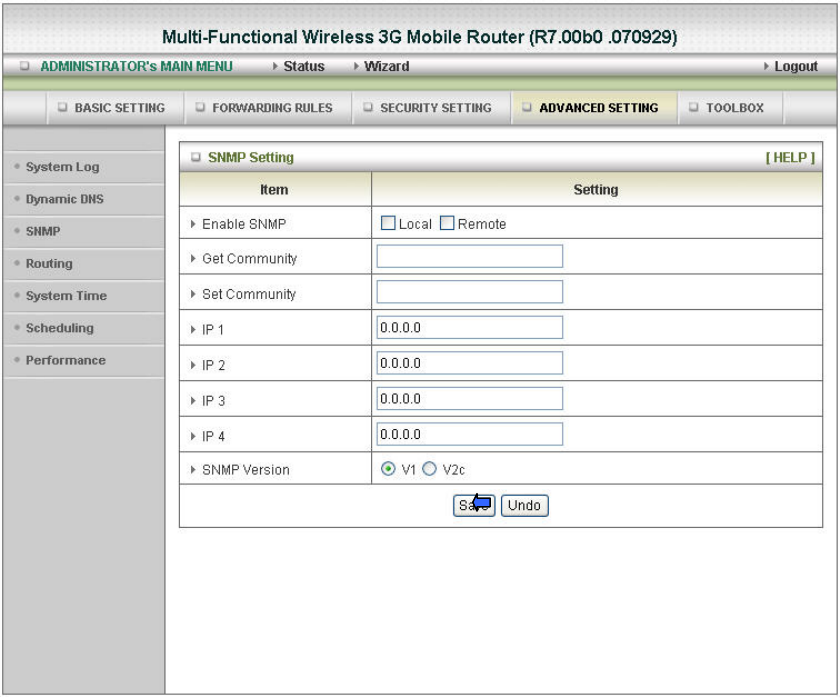
QoS Priority
This defines the priority level of the current Policy Configuration. Packets associated with this
policy will be serviced based upon the priority level set. For critical applications High or Normal
levels are recommended. For non-critical applications select a Low level.
Enable
Check to enable each rule.
Click on “Save” to store what you just select or “Undo” to give up
Advanced Setup > Advanced Setting > SNMP
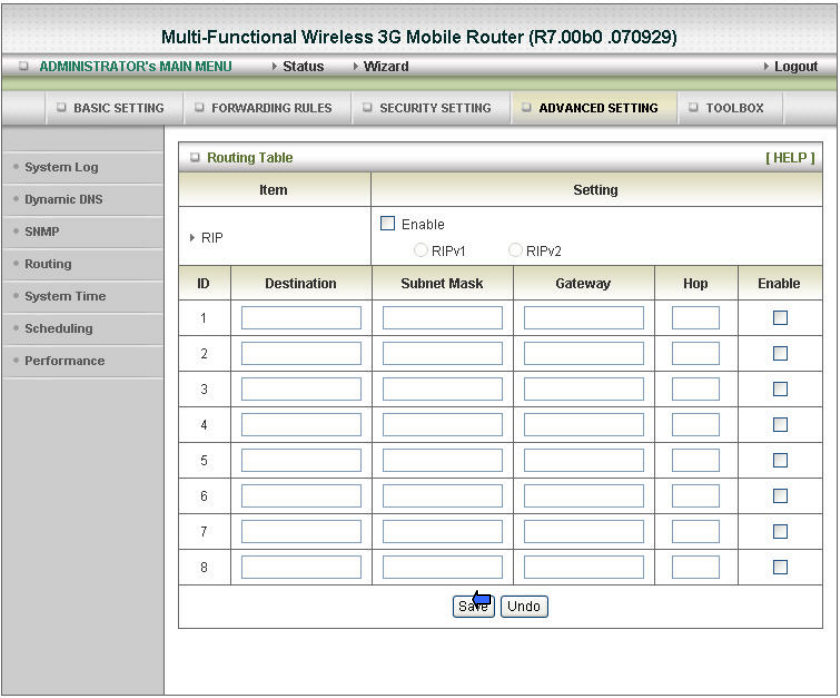
In brief, SNMP, the Simple Network Management Protocol, is a protocol designed to give a
user the capability to remotely manage a computer network by polling and setting terminal
values and monitoring network events.
Enable SNMP
You must check either Local or Remote or both to enable SNMP function. If Local is
checked, this device will response request from LAN. If Remote is checked, this device
will response request from WAN.
Get Community
Setting the community of GetRequest your device will response.
Set Community
Setting the community of SetRequest your device will accept.
IP 1,IP 2,IP 3,IP 4
Input your SNMP Management PC’s IP here. User has to configure to where this device
should send SNMP Trap message.
SNMP Version
Please select proper SNMP Version that your SNMP Management software supports.
Click on “Save” to store what you just select or “Undo” to give up.
Advanced Setup > Advanced Setting > Routing
Routing Tables
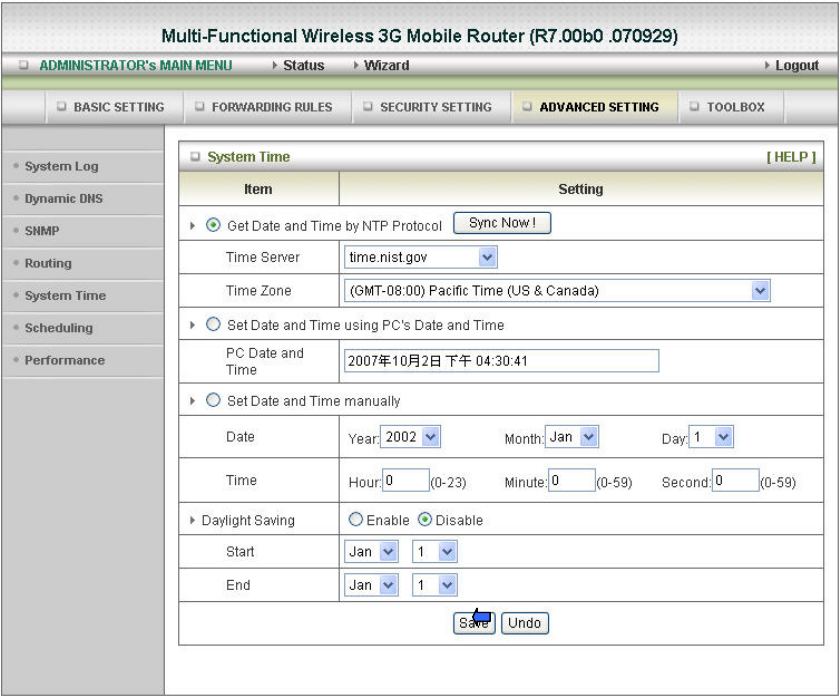
Allow you to determine which physical interface address to use for outgoing IP data grams.
If you have more than one routers and subnets, you will need to enable routing table to allow
packets to find proper routing path and allow different subnets to communicate with each
other.
Routing Table settings are settings used to setup the functions of static and dynamic routing.
Dynamic Routing
Routing Information Protocol (RIP) will exchange information about destinations for
computing routes throughout the network. Please select RIPv2 only if you have different
subnet in your network. Otherwise, please select RIPv1 if you need this protocol.
Static Routing
For static routing, you can specify up to 8 routing rules. You can enter the destination IP
address, subnet mask, gateway, hop for each routing rule, and then enable or disable the rule
by checking or un-checking the Enable checkbox.
Click on “Save” to store what you just select or “Undo” to give up.
Advanced Setup > Advanced Setting > System Time
Get Date and Time by NTP Protocol
Selected if you want to Get Date and Time by NTP Protocol.
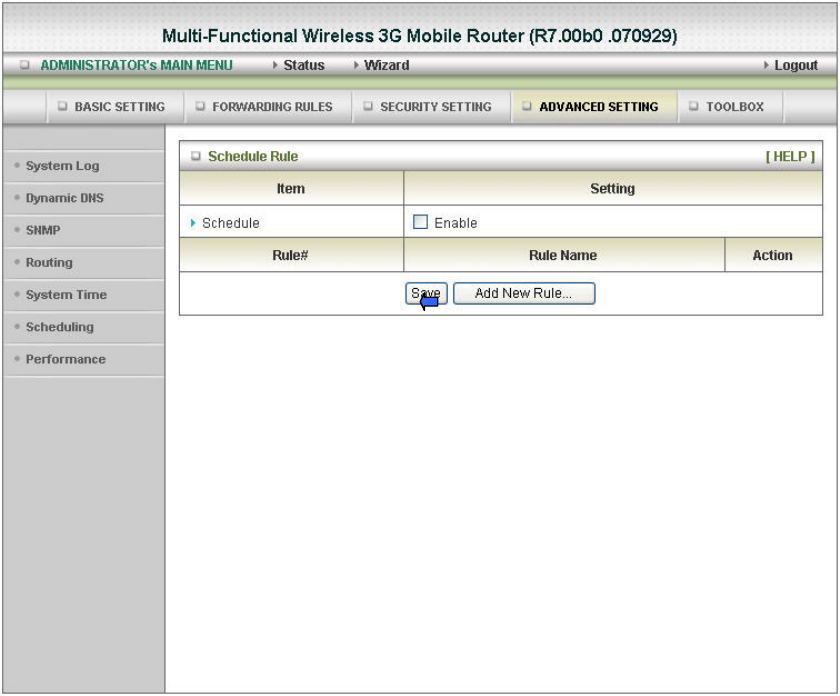
Time Server
Select a NTP time server to consult UTC time
Time Zone
Select a time zone where this device locates.
Set Date and Time using PC’s Date and Time
Set the Date and Time from your PC
Set Date and Time manually
Selected if you want to Set Date and Time manually.
Daylight Saving
Click on “Save” to store what you just select or “Undo” to give up.
Advanced Setup > Advanced Setting > Scheduling
You can set the schedule time to decide which service will be turned on or off.
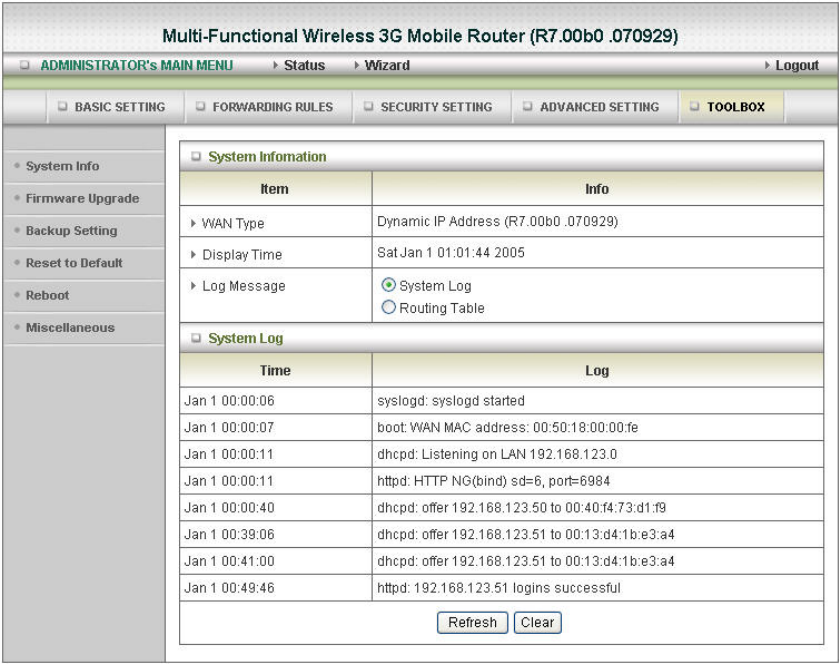
Advanced Setup > Tool Box > System Info
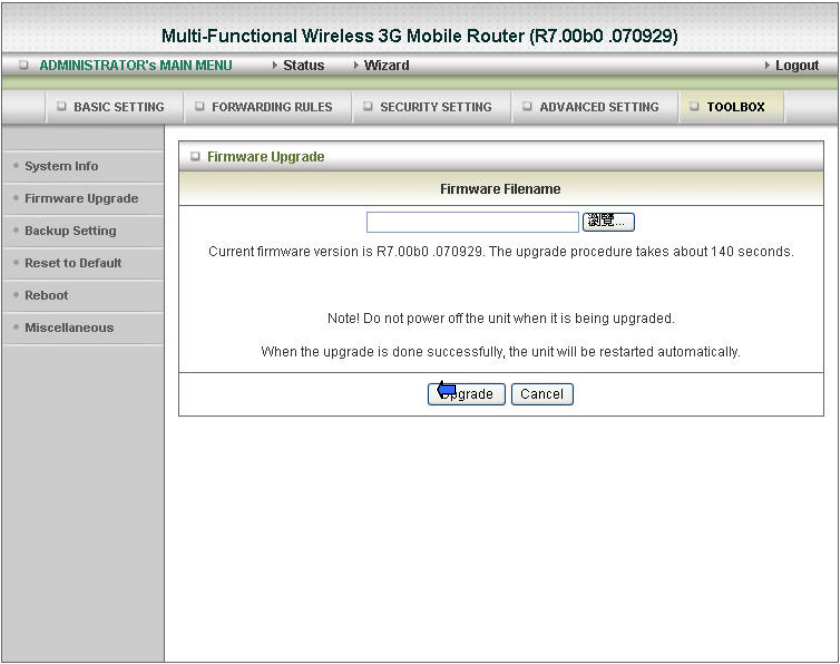
You can view the System log, Routing Table information in this page
Advanced Setup > Tool Box > Firmware Upgrade
You can upgrade firmware by clicking Firmware “Upgrade” button
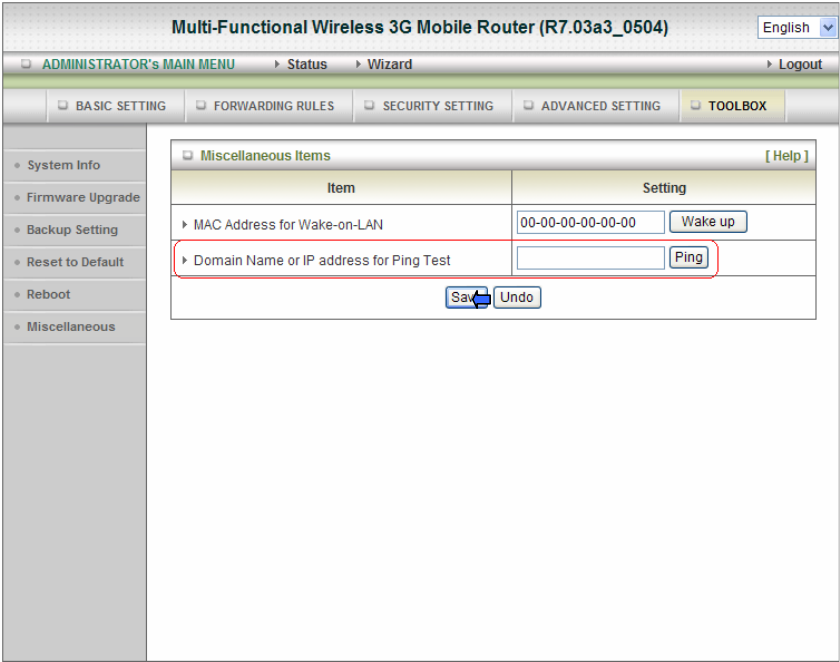
Advanced Setup > Tool Box > Backup Setting
You can backup your settings by clicking the Backup Setting button and save it as a bin
file. Once you want to restore these settings, please click Firmware Upgrade button and
use the bin file you saved
Advanced Setup > Tool Box > Reset to Default
You can also reset this product to factory default by clicking the Reset to
default button
Advanced Setup > Tool Box > Reboot
You can also reboot this product by clicking the Reboot button
Advanced Setup > Tool Box > Miscellaneous
MAC Address for Wake-on-LAN
Wake-on-LAN is a technology that enables you to power up a networked device remotely.
In order to enjoy this feature, the target device must be Wake-on-LAN enabled and you
have to know the MAC address of this device, say 00-11-22-33-44-55. Clicking "Wake
up" button will make the router to send the wake-up frame to the target device
immediately.
Domain Name or IP address for Ping Test
You can key in URL or IP address, and then click the “Ping” button for test.
3. Troubleshooting
This section provides an overview of common issues, and possible solutions for the installation
and operation of the Wireless WAN Mobile Broadband Router.
1. Unable to access the Configuration Menu when I use my computer to configure the
router. Why?
Note: It is recommended that you use an Ethernet connection to configure the
Ensure that the Ethernet LED on the Wireless WAN Mobile Broadband Router is ON.
If the LED is NOT ON, check to see if the cable for the Ethernet connection is securely inserted.
Note: Ensure that the IP Address is in the same range and subnet as the Wireless WAN
Mobile Broadband Router. The IP Address of the Wireless WAN Mobile Broadband Router
is 192.168.123.254. All the computers on the network must have a unique IP Address within
the same range (e.g., 192.168.123.x). Any computers that have identical IP Addresses will
not be visible on the network. All computers must also have the same subnet mask (e.g.,
255.255.255.0).
Do a Ping test to make sure that the Wireless WAN Mobile Broadband Router is responding.
Go to Start > Run.
1:Type cmd.
2:Press Enter.
3:Type “ping 192.168.123.254”. A successful ping shows four replies.
Note: If you have changed the default IP Address, ensure you ping the correct IP
Address assigned to the Wireless WAN Mobile Broadband Router.
Ensure that your Ethernet Adapter is working properly, and that all network drivers are installed
properly.
Note: Network adapter names will vary depending on your specific adapter. The installation
steps listed below are applicable for all network adapters.
1. Go to Start > My Computer > Properties.
2. Select the Hardware Tab.
3. Click Device Manager.
4. Double-click on “Network Adapters”.
5. Right-click on Wireless Cardbus Adapter, or your specific network adapter.
6. Select Properties to ensure that all drivers are installed properly.
7. Look under Device Status to see if the device is working properly.
8. Click “OK”.
2: Why my wireless client can NOT access the Internet?
Note: Establish WiFi Connection. As long as you select either WEP or WPA-PSK encryption,
ensure encryption settings match your WiFi settings. Please refer to your WiFi adapter
documentation for additional information.
Ensure that the wireless client is associated and joined with the correct Access Point.
To check this connection, follow the steps below:
1. Right-click on the Local Area Connection icon in the taskbar.
2. Select View Available Wireless Networks in Wireless Configure. The Connect to
Wireless Network screen appears. Ensure you have selected the correct available network.
Ensure the IP Address assigned to the wireless adapter is within the same subnet as the Access
Point and gateway. The Wireless WAN Mobile Broadband Router has an IP Address of
192.168.123.254. Wireless adapters must have an IP Address in the same range (e.g.,
192.168.123.x). Although the subnet mask must be the same for all the computers on
the network, no two devices may have the same IP Address. Therefore, each device must have
a unique IP Address.
To check the IP Address assigned to the wireless adapter, follow the steps below:
1.Enter ipconfig /all in command mode
2.Enter ping 192.168.123.254.to check if you can access the Wireless WAN Mobile Broadband
Router
3. Why does my wireless connection keep dropping?
You may try following steps to solve.
• Antenna Orientation.
1: Try different antenna orientations for the Wireless WAN Mobile Broadband Router.
2: Try to keep the antenna at least 6 inches away from the wall or other objects.
• Try changing the channel on the Wireless WAN Mobile Broadband Router, and your
Access Point and Wireless adapter to a different channel to avoid interference.
• Keep your product away (at least 3-6 feet) from electrical devices that generate RF noise,
like microwaves, monitors, electric motors, etc.
4. Why I am unable to achieve a wireless connection?
Note: An Ethernet connection is required to troubleshoot the Wireless WAN Mobile
Broadband Router.
If you have enabled Encryption on the Wireless WAN Mobile Broadband Router, you must
also enable encryption on all wireless clients in order to establish a wireless connection.
• For 802.11g, the encryption settings are: 64 or 128 bit. Ensure that the encryption bit level
is the same for both the Wireless WAN Mobile Broadband Router, and your Wireless
Client.
• Ensure that the SSID (Service Set Identifier) on the Wireless WAN Mobile Broadband
Router and the Wireless Client are exactly the same.
If they are not, your wireless connection will not be established.
• Move the Wireless WAN Mobile Broadband Router and the wireless client into the same
room, and then test the wireless connection.
• Disable all security settings such as WEP, and MAC Address Control.
• Turn off the Wireless WAN Mobile Broadband Router and the client.
Turn the Wireless WAN Mobile Broadband Router back on again, and then turn on the
client.
• Ensure that all devices are set to Infrastructure mode.
• Ensure that the LED indicators are indicating normal activity. If not, ensure that the AC
power and Ethernet cables are firmly connected.
• Ensure that the IP Address, subnet mask, gateway and DNS settings are correctly entered
for the network.
• If you are using 2.4GHz cordless phones, X-10 equipment, or other home security systems,
ceiling fans, or lights, your wireless connection may degrade dramatically, or drop
altogether.
To avoid interference, change the Channel on the Wireless WAN Mobile Broadband Router,
and all devices in your network.
• Keep your product at least 3-6 feet away from electrical devices that generate RF noise.
Examples include: microwaves, monitors, electric motors, and so forth.
5. I just do not remember my encryption key. What should I do?
• If you forgot your encryption key, the WiFi card will be unable to establish a proper connection.
If an encryption key setting has been set for the Wireless WAN Mobile Broadband Router, it
must also be set for the WiFi card that will connect to the Wireless WAN Mobile Broadband
Router.
To reset the encryption key(s), login to the Wireless WAN Mobile Broadband Router using a
wired connection. (Please refer to “Basic > Wireless (Security–No Encryption)” on page 10, for
additional information).
7. How do I reset my Wireless WAN Mobile Broadband Router to its factory default
settings?
If other troubleshooting methods have failed, you may choose to Reset the Wireless WAN
Mobile Broadband Router to its factory default settings.
To hard-reset the Wireless WAN Mobile Broadband Router its factory default settings, follow
the steps listed below:
1. Ensure the Wireless WAN Mobile Broadband Router is powered on
2. Locate the Reset button on the back of the Wireless WAN Mobile Broadband Router.
3. Use a paper clip to press the Reset button.
4. Hold for 10 seconds and then release.
5. After the Wireless WAN Mobile Broadband Router reboots, it is reset to the factory default
settings.
Note: Please note that this process will take a few minutes.
8. What is VPN?
• VPN stands for “Virtual Private Networking.” VPNs create a "tunnel" through an existing
Internet connection using PPTP (Point-to-Point Tunneling Protocol) or IPSec (IP Security)
protocols with various encryption schemes including Microsoft Challenge Handshake
Authentication Protocol (MS-CHAP) .
• This feature allows you to use your existing Internet connection to connect to a remote site with
added security. If your VPN connection is not functional, verify that your VPN dial-up
configuration is correct.
Note: This information should be provided to you from your VPN provider.
Pressing the Reset Button restores to its original factory default settings.
9. What can I do if my Ethernet cable does not work properly?
• First, ensure that there is a solid cable connection between the Ethernet port on the Router, and
your NIC (Network Interface Card).
• Second, ensure that the settings on your NIC adapter are “Enabled,” and set to accept an IP
address from the DHCP.
• If settings appear to be correct, ensure that you are not using a crossover Ethernet cable.
Although the Wireless WAN Mobile Broadband Router is MDI/MDIX compatible, not all NICs
are. Therefore, it is recommended that you use a patch cable when possible.
Technical Support 45

4. Technical Specifications
3G Access 1*PC card Type II Slot
USB port
Standards IEEE 802.11b/g
Standard IEEE 802.11b\g Turbo
Data Rate 54, 48, 36, 24, 18, 12, 11, 9, 6, 5.5, 2, 1 Mbps per channel, Auto Fall-Back
Frequency 2.412 – 2.462 GHz, DSSS / OFDM modulation
Range Coverage Tx/Rx power 18dbm/Per Cell
indoors approx. 35-100 meters;
outdoors up to 100-300 meters
# of Channels 1-11 for N. America (FCC);1-11 for Canada (DOC)
1-13 Europe (Except Spain and France) (ETSI)
1-14 Japan (TELEC);
Security 64-bit and 128-bit WEP Encryption; WPA encryption
Antenna Dipole Antenna 2dBi
Firewall IP Filtering
NAT (Network Address Translation) with VPN Pass through
MAC Filtering
Supported WAN type 3G,Static IP, Dynamic IP, PPPoE,PPTP,L2TP
Connection Scheme Connect-on-demand, Auto-Disconnect
NAT function Class C ;One-to-Many; Max 253 Users; Virtual Server; DMZ Host
VPN PPTP, L2TP and IPSec Pass Through
Config.&
Management Web-Based IE, Nevigator browser and SNMP
DHCP Server and Client
Working
Environment Temperature: 0~40oC, Humidity 10%~90% non-condensing
OS supported Windows 95/98/ME/NT/2000/XP; Linux
Power Switching 5V 3.0A
Power IEEE 802.11b Mode : 19.69+-0.78dBm
IEEE 802.11g Mode : 21.41+-0.92dBm
